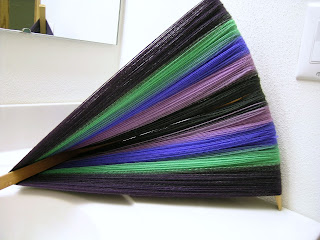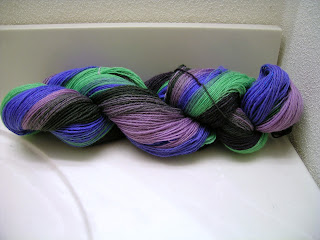Finished spinning the Loop bullseye bump. Let it rest on the bobbin overnight and then chain plied it on my Louet wheel.
 |
| Plied "Goddess" from Loop on the Niddy Noddy |
I have a system for chain plying that works well on that wheel. I put the full bobbin of singles behind my shoulder on a ledge behind my spinning chair. I draw off the bobbin in a straight line to the orifice of the wheel so I don't have as much snarling of the singles as I work. To do the chain ply, I tie a loop onto the bobbin leader and put my right hand thumb and forefinger through the loop. Then I draw a loop of singles through the loop on my right hand with my left hand forefinger and draw it out about 20-24" (I've never measured - oops!) until my left hand reaches a spot on the wall. Then I bring the loop over to the continuous strand from the bobbin and do a counted number of treadles, in this case 13. I do this for consistency of my plying twist - and I
do count treadles, then stop the flyer and wind on the finished yarn. Fiddly, yes, but I like the evenness I get in my yarn from all the counting. It isn't perfect, I don't think handspun is, or at least mine never is perfect. But I love my yarn, so it works for me.
 |
| Full view of the finished yarn on the Niddy Noddy. |
This skein's vital statistics are as follows: Loop bullseye bump in the "Goddess" colorway. I don't think this is one of the repeatable ones. Fiber content is Merino, bamboo and tussah silk in undisclosed percentages. At a guess, I'd say about half Merino from the way it spins up. It became a very nice and soft yarn. Not much sheen or springiness, probably because of the silk and bamboo. The skein weight is 4.7 ounces or 132 grams, length is 686 yards and 24 wraps per inch before washing. It isn't dry yet, but it doesn't seem to have much spring to it, so I don't think there will be much change in this skein as it dries.
 |
| Full view of the "Goddess" skein |
I washed the skein in hot water with a small squeeze of Dawn Olay Hand Renewal dish liquid in the Lavender scent. I was really hoping for some color bleed to tone down the bright green, but that didn't happen. I may still split off the colors later on, but I'm currently considering a round yoke sweater using this yarn for the colorwork portion. If I break up the colors, I could overdye that green with something else to tone it down - maybe a peacock blue or a darker green, just to knock the intensity down a notch. Another option would be to plan the colorwork specifically to break up the stitches to small "pops" of the green. The quilters call that kind of oddball color a "poison color" that is needed to energize the color scheme of a project. In a colorwork yoke, I'm thinking of doing something floral... maybe iris or violets... or maybe something abstract, I haven't decided. The grist of 24 wraps per inch makes it a fingering weight yarn, so I do have plenty of options. Many suppliers make a grand array of colors in this yarn weight.
 |
Close up of the "Goddess" skein - color is more accurate in the full skein photo.
|
This seems to be my default yarn. It is what I naturally seem to spin. Unless the fiber wants to be something else - but then I have to pay closer attention to maintain some other grist. But I do make the attempt, especially with the superfine wools I've been sampling lately. Speaking of that, I'll show you what I've been sampling in the last few weeks.
This particular sample is also from the
Loop Fiber Studio and it came in the box along with the Goddess bump as a gift. It is a sample of Steph's Spontaneous Spinning Clouds. The fiber is carded but not aligned in a batt or top. This little bit had white and a pale pink fiber with a smidgen of sparkle fiber that appears to be Angelina. No fiber notations were made so I can only speculate what might be in this yarn.
It is pretty stuff, a 5 gram sample, and I got 20 yards of chain plied soft yarn with a pale golden glimmer that is quite appealing. Only enough for a little accent on a knitted piece, but scrumptious enough to be worth it.
Also in progress is some of the Grand Champion Targhee fleece that I purchased at the Wisconsin Sheep and Wool Festival last month. I chose some of the fleece near one edge and did some lock washing on it. Then I flick carded and spindle spun some of it quite fine. Chain plied on the spindle - because the Louet pulls too hard to ply a super fine yarn, it breaks the singles. We have an understanding now, and there is much less frustration. There are some things a Louet S-10 does marvellously well, but fine yarn isn't one of them.
 |
| Grand Champion Targhee fleece, yarn sample |
Statistics on this sample are thusly: spindle spun singles clockwise, spindle chain plied counter clockwise. Before washing, it measured 28 wraps per inch and 13 yards. After washing the sample is 27 wraps per inch and 12 yards in length. Pretty springy yarn, not quite as much as the super fine Corriedale that I prepared with the same method. This is a very pleasant yarn, still in the fingering weight range, even though it feels finer. It will be a great pleasure to work through this lovely fleece!


